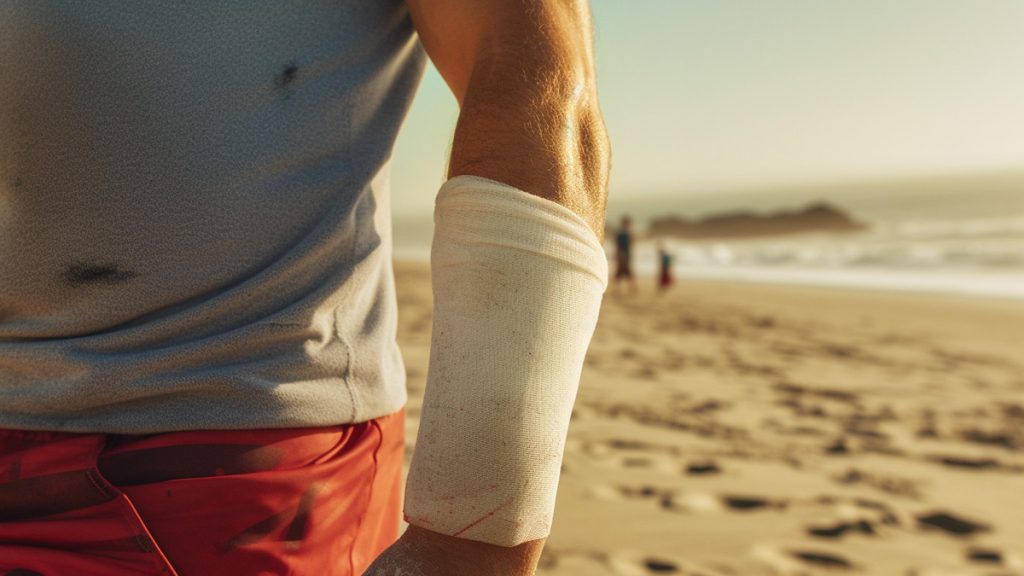Most Common Injuries Sustained While Surfing

Is there anything more iconic than catching a wave at one of the Bay Area’s famed surf spots? Locals and tourists alike flock to our sandy beaches to get their fill of sea and sun.
Surfing is a great way to stay fit, but it can also cause its fair share of injuries. While most surfing injuries are minor, knowing the risks can help beginners and pros stay safe on the waves.

Table of Contents
Short-term Injuries
The most common surfing injuries are minor and short-term. Following basic surfing safety rules can reduce the chances of these less serious injuries.
Lacerations and Cuts
When a typical surfer goes out in the water, their legs, arms, and other body parts are exposed to the jagged surfaces on the sea bed, the rocky coastline, and their own board fins. Wiping out can result in cuts and scrapes, especially on the lower half of the body.
While small cuts may not seem like a big deal, they can create a pathway for serious infections like Staphylococcus to enter the bloodstream. For this reason, health experts advise treating cuts, no matter how small, right away.
A basic first aid kit can treat most common surf injuries. Surfers should clean out the wound with a saline solution. Covering the injury with antibiotic ointment can prevent infection. Gauze wrap or plastic bandaids can promote healing and protect against bacteria. Since most bandages are not water-resistant, it may be best to take a break from the waves until the wound heals on its own.
In some cases, surfers can experience deep lacerations. The first step is to stop the bleeding by pressing a gauze wad against the wound. Next, seek medical attention as soon as possible. Deep wounds may need stitches and can become severely infected without proper treatment.

Contusions and Abrasions
Not all surfing injuries break the skin. Bruises, swelling, and scrapes are common occurrences in surfing. Bruising happens when the blood vessels below the skin are damaged. They may appear red, purple, or black. Most bruises disappear after a week or so without treatment. However, bruises can also be a symptom of a more serious problem. If a bruise is accompanied by intense swelling and pain, it could indicate a broken bone or internal bleeding.
Abrasions or scrapes happen when the first layer of skin gets irritated or damaged. Like cuts, abrasions should be cleaned out with an antibiotic and dressed in a bandage or gauze.
While it can be difficult to avoid bruising and abrasions, surfers can protect themselves by wearing full-bodysuits. If you’re new to hitting the waves, choose safe ways to surf. For example, make sure that the wave intensity and beach conditions match your experience level. Also, follow surf etiquette to prevent colliding with other surfers, beachgoers, and marine life.
Surfer’s Ear (Exostosis)
Heading out in the windy surf is exhilarating, but it also provides the perfect conditions for surfer’s ear. After years of exposure to cold water and air, the tiny bones in the ear canal develop hard growths. These bony knobs can block the ear canal and lead to hearing loss. Surfer’s ear can also increase the risk and frequency of ear infections.
Mild cases of surfer’s ear are treated with antibiotics or special ear drops. The most severe cases will require minor surgery. Surfer’s ear is treatable, but it can always return after repeated exposure to cold water.
Prevention is the best way to stop this common surf injury. Surfers should wear well-fitting earplugs every time they go in the water, especially if the temperature is below 66 degrees Fahrenheit.

Long-term Injuries
Like many other physical sports, surfing can also lead to long-term musculoskeletal injuries. Thankfully, there are steps surfers can take to strengthen their bodies and keep themselves in top condition for years to come.
Knee Injuries
Knees are especially vulnerable to surfing injuries. This is because some surfing moves cause the surfer to hold their back knee in a dangerous position. If the knee gets twisted or sprained, it can damage the fragile ligaments that connect the knee bone to the leg bones.
Ligament injuries can be debilitating. A sprained or torn ligament requires weeks of physical therapy to regain full mobility. Recovery means taking precious time away from the waves.
Preventing surfing knee injuries requires holding the body in the correct position both on and off the board. Doing exercises that strengthen the abs, hips, and knees can stabilize the body and make it easier to maintain a healthy posture while riding.

Shoulder Injuries
Surfers are at risk of overuse injuries, especially in the shoulders. Experienced riders can develop surfer’s shoulder, which happens when the muscles around the shoulder develop unevenly.
When this happens, the overused muscle compensates for the underused weaker ones. Over time, the overworked muscles can become worn and overstretched. This can cause pain and swelling in the shoulders.
Surfers should take this pain as a warning to take a break and rest the injured area. Ignoring the pain and continuing to surf as usual can cause the muscle to tear and lead to a much more prolonged injury. Once this happens, more serious interventions like surgery or physical therapy may be required.
Following a balanced workout plan can prevent uneven shoulder muscle development. Focus on exercises that engage the entire rotator cuff, back, and deltoid muscles.
How Working Out Helps Prevent Injuries
Preventing long-term surfing injuries depends equally on what you do in and out of the water. The right exercise routine helps strengthen the core muscles, making it easier to control the board and protect injury-prone joints.
The ideal routine should contain a variety of exercises that target muscle groups in the upper and lower body. Weight training exercises like squats, pullups, and push-ups are great for building muscle and endurance. Stretches also support mobility and reduce the risk of overuse injuries.
Joining a gym is one of the easiest ways to ensure that you are training the right muscles. Many gyms in San Diego have on-site personal trainers who can help you create the perfect routine based on your fitness goals.
Understanding Other Risks While Surfing
Surfing safety is more than just injury prevention. Knowing how to read the environment and water conditions can be lifesaving. Strong wind can make for amazing waves, but it also increases the skill and strength needed to navigate the waters. At the same time, rain can be a hazard for beginners and experienced surfers alike as storms increase the risk of water-borne infections.
Environmental phenomena like rip currents can also catch surfers off guard. Keep an eye out for breaks in the waves. If you’re ever caught in a current, swim off to the side to escape its pull, then head for the shoreline.
Surfers must also take precautions to protect local marine life. After all, the ocean is their home, and we are just visitors. Riders should avoid surfing over coral reefs or leaving trash or gear in the ocean. Choose wetsuits made from recycled materials and wear sunscreen with environmentally safe ingredients.
Conclusion
Some surfing injuries are unavoidable, but there is a lot surfers can do to reduce their severity. Wearing the right protective gear can prevent scrapes and bruises in the short term and surfers’ ear in the long term. Also, a well-rounded workout routine can prevent musculoskeletal injuries by increasing strength and mobility.
Finally, surfers should always be aware of their surroundings, and ensure that water conditions match their experience level. Follow these basic rules, and you’ll be sure to enjoy your time on the water.

Media credits: Unless otherwise noted, images in this article are copyright of LaJolla.com







